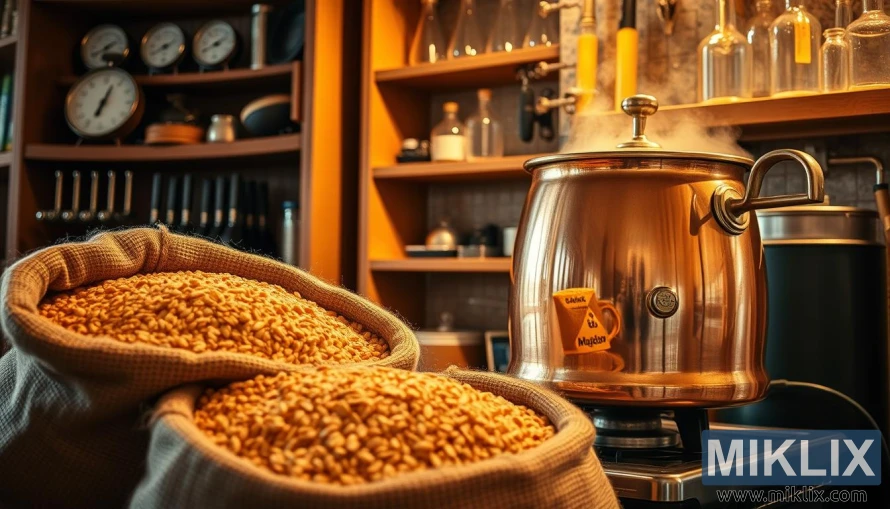Image: Cozy brewing with mild ale malt
Published: July 22, 2025 at 9:36:39 PM UTC
Last updated: September 27, 2025 at 3:37:24 PM UTC
A copper kettle steams on a vintage stove as burlap sacks of mild ale malt spill grains, with tools on shelves and warm light evoking a rich, full-bodied ale.
In a warmly lit corner of a dedicated brewing space, the scene captures the essence of small-batch craftsmanship and the quiet satisfaction of hands-on creation. The focal point is a gleaming stainless steel brewing kettle, its polished surface reflecting the ambient glow of golden light that fills the room. Steam rises gently from the kettle’s open top, curling into the air like a whisper of the transformation underway within. The kettle is fitted with a temperature gauge and safety labels—“Hot Surface” and “Caution”—subtle reminders of the precision and care required in the brewing process. This is not a hurried operation; it’s a ritual, a slow unfolding of flavor and chemistry.
In the foreground, two large burlap sacks overflow with malted barley grains, their rich, toasted hues ranging from warm amber to deep russet. The grains spill naturally onto the wooden floor, their smooth, elongated shapes catching the light and adding texture to the composition. These are mild ale malts, chosen for their mellow sweetness and subtle nutty character, and their presence here suggests a brew that will be full-bodied yet approachable—something comforting, perhaps with hints of biscuit and honey. The burlap sacks, rough and utilitarian, contrast beautifully with the sleek metal of the kettle, reinforcing the theme of tradition meeting modernity.
Behind the kettle, shelves line the wall, meticulously stocked with brewing tools and glassware. Thermometers, hydrometers, and graduated cylinders stand ready for use, each one a testament to the brewer’s commitment to accuracy and consistency. Beakers and flasks glint under the warm lighting, their clean lines and transparent surfaces adding a touch of laboratory precision to the otherwise rustic setting. The shelves themselves are wooden, slightly worn, and filled with the quiet character of a space that has seen many brews and many seasons. This is a place of learning and experimentation, where each batch is both a product and a process.
The lighting in the room is soft and golden, casting long shadows and highlighting the contours of the equipment and ingredients. It creates an atmosphere that is both industrious and inviting, suggesting that this is not just a workspace but a sanctuary. The glow enhances the natural tones of the malt, the metal, and the wood, tying the elements together in a cohesive visual harmony. The air, though invisible, seems thick with the aroma of roasted grains, warm steam, and the faint metallic tang of brewing equipment. It’s a scent that evokes comfort, anticipation, and the promise of something delicious taking shape.
This image is more than a snapshot—it’s a narrative of intention and care. It tells the story of a brewer who values both the science and the soul of their craft, who understands that great beer begins not just with ingredients, but with environment, attention, and respect for the process. The mild ale malt, central to the composition and the recipe, symbolizes a choice for balance and depth, for a brew that invites rather than overwhelms. The scene invites the viewer to imagine the next steps: the mash, the boil, the fermentation, and finally, the pour. It’s a portrait of brewing as a personal, tactile, and deeply satisfying endeavor—where every grain, every tool, and every moment contributes to the creation of something worth savoring.
The image is related to: Brewing Beer with Mild Ale Malt

